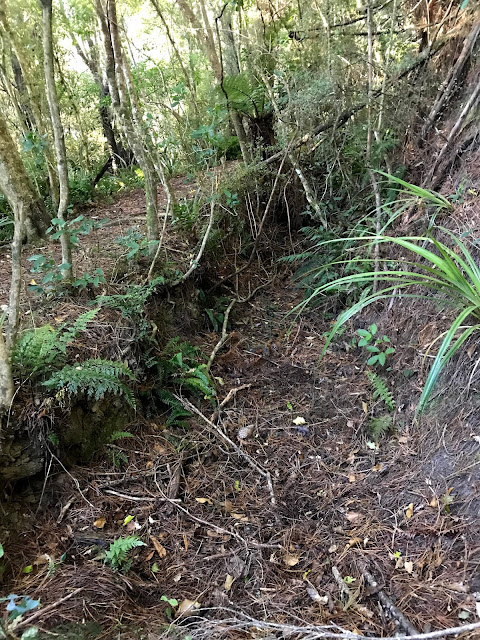Expanding My Heritage Bubble
Kia ora,
Over the last couple of weeks I've been fortunate enough to be able to take advantage of the slightly relaxed COVID-19 restrictions by visiting some local walking tracks around Dunedin. This included a walk along one of The Silver Stream Water Race Tracks.
Water races are a familiar component of historic goldfield archaeology in New Zealand. These are channels that were cut across hillsides to bring water from streams to places where gold was mined. The Silver Stream Water Race was not established to supply water for gold mining however, but to help meet the demand for water of a rapidly expanding urban population in the nineteenth century.
In the earliest days of Dunedin (founded in 1848) water supplies were taken from creeks and springs in the area. The population of Dunedin grew rapidly following the Otago Gold Rushes in the early 1860s and from 1867 the Ross Creek Reservoir provided a more reliable supply of water. However, by the mid 1870s this reservoir was no longer sufficient to meet the needs of the city. A drought and fire in December 1877 emphasized the need for additional water and led to the development of the Silver Stream Water Race. The race was completed in 1881 and transported water for 29 kilometres from the Silver Stream, which drained the slopes of the Flagstaff range, to an additional city reservoir (the Southern Reservoir) in the Kaikorai Valley (see McDonald 1965, especially pp. 145-152, for more historical background). The race required constant maintenance and by the early twentieth century the most troublesome parts of the original open race and timber fluming had been replaced by concrete and iron pipes (McDonald 1965: 275).
The race has not been in use since the 1950s, although the Silver Stream remains a source of Dunedin's water (the current pumping station moves water along a buried pipeline following a new route to the Southern Reservoir). Nonetheless, plenty of the historic water race infrastructure remains to be enjoyed along the present walking track circuits, along with some great natural scenery!
Water races are a familiar component of historic goldfield archaeology in New Zealand. These are channels that were cut across hillsides to bring water from streams to places where gold was mined. The Silver Stream Water Race was not established to supply water for gold mining however, but to help meet the demand for water of a rapidly expanding urban population in the nineteenth century.
 |
| View of North Dunedin ca. 1861 (Hocken Snapshop, Item 0518_01_003A). |
 |
| North Dunedin in December 1874 (To create this image I've stitched together two separate photos taken from the steeple of Dunedin's First Church and sourced from Hocken Snapshop). |
In the earliest days of Dunedin (founded in 1848) water supplies were taken from creeks and springs in the area. The population of Dunedin grew rapidly following the Otago Gold Rushes in the early 1860s and from 1867 the Ross Creek Reservoir provided a more reliable supply of water. However, by the mid 1870s this reservoir was no longer sufficient to meet the needs of the city. A drought and fire in December 1877 emphasized the need for additional water and led to the development of the Silver Stream Water Race. The race was completed in 1881 and transported water for 29 kilometres from the Silver Stream, which drained the slopes of the Flagstaff range, to an additional city reservoir (the Southern Reservoir) in the Kaikorai Valley (see McDonald 1965, especially pp. 145-152, for more historical background). The race required constant maintenance and by the early twentieth century the most troublesome parts of the original open race and timber fluming had been replaced by concrete and iron pipes (McDonald 1965: 275).
The race has not been in use since the 1950s, although the Silver Stream remains a source of Dunedin's water (the current pumping station moves water along a buried pipeline following a new route to the Southern Reservoir). Nonetheless, plenty of the historic water race infrastructure remains to be enjoyed along the present walking track circuits, along with some great natural scenery!
 |
| Culvert along race. Photos by author. |
 |
| Me standing next to a moss-covered section of deteriorating iron pipe. Photo taken by my girlfriend Jess (hiking is her thing, heritage is mine - we found a nice little middle ground here!). |
 |
| One of the scenic views along the way! Another great photo taken by Jess (check out an Instagram account for her photography here). |
Thanks for reading,
Nick
P.S. As even a cursory glance of the posts on this blog will indicate, I write about a very broad range of topics - from the Middle Pleistocene to the archaeology of twentieth century conflict. If it is a particular interest in the topic that I have discussed in this post that has brought you here, here are links to some more specialized New Zealand archaeology blogs that you may find of interest:
Christchurch uncovered and The city remains are two blogs focused on the archaeology of my hometown Christchurch.
The Southern Cemeteries Archaeology Project Blog is the blog of an active research project led by archaeologists and biological anthropologists from the University of Otago focused on the lives of nineteenth century European and Chinese settlers in the lower South Island of New Zealand.
Reference
McDonald, K.C. 1965. City of Dunedin: A Century of Civic Enterprise. Dunedin: Dunedin City Corporation.








Comments
Post a Comment